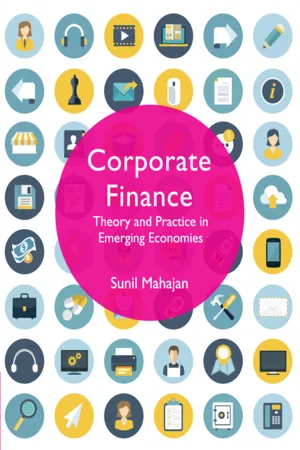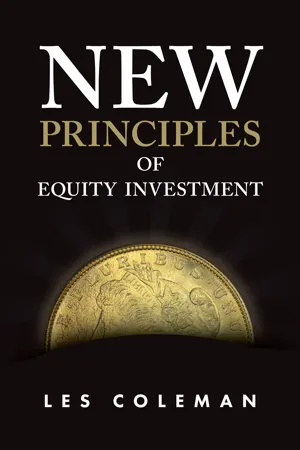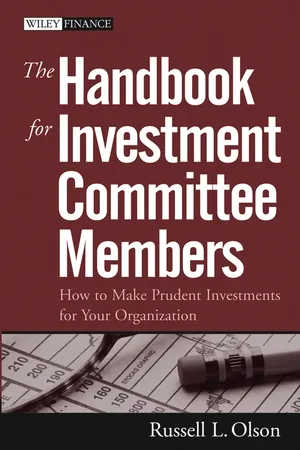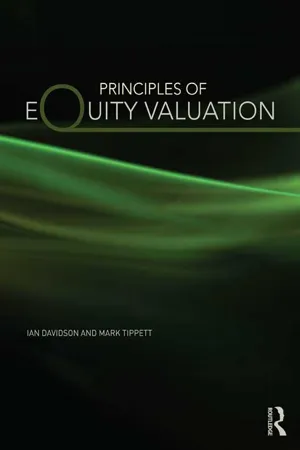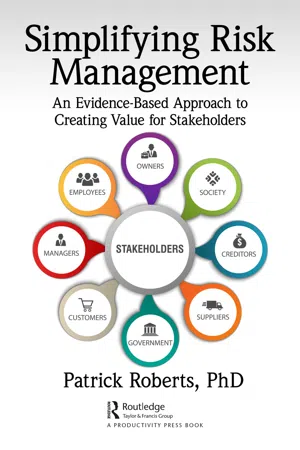Economics
Risk and Return
Risk and return are fundamental concepts in investment and finance. Risk refers to the uncertainty or potential for loss associated with an investment, while return is the gain or profit earned from that investment. Generally, higher returns are expected to come with higher levels of risk, and investors must carefully consider and balance these factors when making investment decisions.
Written by Perlego with AI-assistance
Related key terms
1 of 5
9 Key excerpts on "Risk and Return"
- eBook - ePub
- Robert Irons(Author)
- 2019(Publication Date)
- Routledge(Publisher)
3 Risk and ReturnBusinesses constantly face risks, some recurring (like the risk of a competitor designing a newer, better product), others new and different (like the risk of an economic recession) and all seemingly never-ending. Risks come in many different forms and different levels of severity. Part of being a good manager is being able to understand the nature of the risks the firm faces and determine the return necessary to make the risks worth bearing.The last sentence above implies a relationship between Risk and Return, and that relationship is important for you to understand. That relationship is stated clearly in our second fundamental principle (FP2), which identifies the positive nature of the relationship between Risk and Return. This relationship is so important that it is usually a mistake to discuss an investment’s return without also discussing its risk. In this chapter, we will discuss the different types of risk firms (and investors) face, how these risks are measured and how they compare to returns. We will also discuss how to calculate returns over a holding period, as well as how to calculate mean annual returns over an extended period of time.The Fundamental Principles in Action
FP2 states that there is a direct (or positive) relationship between perceived risk and required return. This principle is clearly seen when calculating expected returns using the Security Market Line. PR3 examines the inverse relationship between value and the risk, while PR1 describes the inverse relationship between value and the discount rate. These two precepts are linked by the direct relationship between Risk and Return, since the return to shareholders is used as the discount rate for valuing the firm’s common shares. - eBook - PDF
Corporate Finance
Theory and Practice in Emerging Economies
- Sunil Mahajan(Author)
- 2020(Publication Date)
- Cambridge University Press(Publisher)
As investors, we want a higher return but dislike being exposed to risk. Real life is not so benevolent and there is a direct, positive correlation between Risk and Return. A higher return is accompanied by a higher risk, while if an investor seeks a lower risk, he must accept lower returns. Financial markets offer a wide spectrum of choices for the investor in terms of Risk and Return. These choices ensure that the investor takes the minimum possible risk for the return he is getting or that he gets the maximum return for the specific level of risk he is exposed to. Based on his attitude to risk, each investor can opt for the choice that is appropriate for him. It is crucial for the investors to understand the concept of Risk and Return, the relationship between the two and the method of risk calculation. (And discard the perception of risk being akin to pornography despite the fact that risk is a four-letter word!) Capital Asset Pricing Model (CAPM) ‘Don’t put all your eggs in one basket’ is a familiar adage. According to the principle of diversification, investments should be split into multiple risky assets rather than in a single asset. Each investment should ideally comprise a small proportion of the total portfolio. If the return on a specific asset is poor or negative, its impact on the overall portfolio is likely to be insignificant. In fact, undertaken properly, diversification has the potential to reduce the overall risk of the portfolio without reducing the expected return. A popular saying in finance is that there is no free lunch in financial markets, meaning thereby that if you are aiming for a lower risk, you need to accept a lower return. Diversification is one of the rare tools that reduces the risk of investment without lowering returns. Risk and Return | 139 Let us understand how this happens. Finance theory distinguishes between two kinds of risks, namely unsystematic and systematic risks. - eBook - ePub
- Les Coleman(Author)
- 2019(Publication Date)
- Emerald Publishing Limited(Publisher)
Looking ahead, we will combine the dictionary definition of risk with Knightian uncertainty. Thus the risk of equity investment is a downside measure equal to the hard-to-estimate possibility of return below the investor’s opportunity cost or benchmark. It comes from two sources. One is knowledge risk, or the possibility that new information will emerge to alter the investment decision (see Coleman & Casselman, 2016). The other is uncertainty in outcome, given that return from equity investment is the manifestation of numerous time-varying and non-quantifiable variables.The Relationship between Return and Risk
A central tenet of contemporary finance is the existence of a positive, linear relationship between return and risk. According to Modigliani and Modigliani (1997, p. 45), for instance: ’it is well known that investors can increase expected returns simply by accepting a greater level of risk’. In their introduction to a study on the topic, Ghysels, Santa-Clara, and Valkanov (2005) concurred: ’this risk–return tradeoff is so fundamental in financial economics that it could well be described as the "first fundamental law of finance"’.Unfortunately the positive return–risk nexus is an influential misconception that does not stand up to scrutiny. Ex post studies variously report that the relationship is significantly positive, significantly negative and insignificant (see a summary of disparate results in Scruggs, 1998). When Risk and Return are considered ex ante as their expected values, neither can be directly observed nor even has a reasonable proxy, so any link between them cannot be tested. There are practical reasons to doubt a positive return–risk relationship because it is unable to accommodate securities that have a negative expected return such as firms in bankruptcy; and a linear return–risk trade-off has the challenging corollary that each investment with a given return must have the same risk.In fact, evidence is clear that the return–risk relationship is probably negative rather than positive. For instance, Fama and French (1992) identified a negative relationship between Risk and Return at the equity market level. An analogous finding comes from observation that idiosyncratic risk has an inverse relationship with price-to-book ratio (Amit & Wernerfelt, 1990): a high price-to-book ratio indicates superior management and better investment prospects (Zhang, 2005), which is associated with lower risk. A negative relationship is also found at the firm level where the Bowman (1980) Paradox arose from finding that more profitable companies have lower risk as measured by variability in profits. This inverse return–risk relationship has been widely confirmed in subsequent studies which find consistent evidence that safe, incident-free operations are the most profitable. Typical examples are given by US nuclear power plants where higher reliability is associated with higher earnings by plant operators (Osborn & Jackson, 1988); and also by airline bond ratings which are related to operational safety (Noronha & Singal, 2004) and indicate that low-risk operations accompany low risk of default. Further confirmation came out of my own study of large US firms that are fined for environmental breaches, unsafe workplaces or fraudulent accounting standards and announce product recalls (Coleman, 2010): these indications of inherent operating risk and uncertainty were followed by significant declines in sales margin and shareholder return. - eBook - ePub
The Handbook for Investment Committee Members
How to Make Prudent Investments for Your Organization
- Russell L. Olson(Author)
- 2011(Publication Date)
- Wiley(Publisher)
Over a 10-year interval, Fund A earned 12% per year while Fund B earned only 10% per year. Both funds had negative returns in some years, but in their negative years Fund A was down 5 percentage points more than Fund B. Which was the better fund?The answer may depend on our willingness to take on risk. Risk is the flip side of investment return. The higher the expected return, the higher the expected risk. That’s a truism—and pretty true (although not always). It doesn’t necessarily work the other way, however. The higher the risk does not necessarily mean the higher the return. Casinos, for example, can be high risk, but for the gambler they all have a negative expected return.What is risk?Most fundamentally, risk is the probability of losing money—or that the value of our investment will go down. Most investments other than U.S. Treasury bills and insured bank accounts have some reasonable probability of losing money. Other risks are outlined on the following page.VolatilityThe most widely used definition of risk is volatility—how much market values go up and down over time. Volatility is most widely used because it is the most measurable of all risks. Also, over long intervals of time, the volatility of a portfolio encompasses most of the above risks. Volatility measures the uncertainty surrounding an investment, or a portfolio of investments. Because it is measurable, it is more controllable.How do we measure volatility? The simplest measure is annual standard deviation from the asset’s (or portfolio’s) mean rate of return, the same standard deviation measure we may have learned to calculate in high school or college algebra. A low standard deviation of investment returns over time means we had pretty high certainty of investment results. A high standard deviation means we had a high degree of uncertainty. Low volatility is good, high is bad.EXAMPLES OF SPECIFIC RISKS- Loss of Buying Power.
- eBook - PDF
- Aswath Damodaran(Author)
- 2014(Publication Date)
- Wiley(Publisher)
C HAPTER 3 T HE B ASICS OF R ISK Learning Objectives 3.1. Summarize the characteristics of a good Risk and Return model. 3.2. Describe and compare models for measuring market Risk and Returns, including the capital asset pricing model, the arbitrage pricing model, multifactor models, proxy models and accounting-and debt-based models. 3.3. Discuss the measurement of default risk and the relationship of default risk to interest rates on borrowing. Risk, in traditional terms, is viewed as a negative and something to be avoided. Webster’s dictionary, for instance, defines risk as “exposing to danger or hazard.” The Chinese symbols for risk, reproduced below, give a much better description of risk: M AXIMIZE THE V ALUE OF THE B USINESS (F IRM ) The Investment Decision Invest in assets that earn a return greater than the minimum acceptable hurdle rate The Financing Decision Find the right kind of debt for your firm and the right mix of debt and equity to fund your operations The Dividend Decision If you cannot find investments that make your minimum acceptable rate, return the cash to owners of your business The hurdle rate should reflect the riskiness of the investment and the mix of debt and equity used to fund it The return should reflect the magnitude and the timing of the cash flows as well as all side effects The optimal mix of debt and equity maximizes firm value The right kind of debt matches the tenor of your assets How you choose to return cash to the owners will depend on whether they prefer dividends or buybacks How much cash you can return depends on current and potential investment opportunities 52 Motivation and Perspective in Analyzing Risk 53 The first symbol is the symbol for “danger,” while the second is the symbol for “opportunity,” making risk a mix of danger and opportunity. - eBook - PDF
- Robert Parrino, David S. Kidwell, Thomas Bates(Authors)
- 2016(Publication Date)
- Wiley(Publisher)
We could, for instance, measure risk in relative terms – as we did when we compared the Portuguese and Andalusia real Risk and Return 232 estate investments. Or we can conceive of risk as being the chance of getting an outcome above or below a given value. These different concepts of risk all have a place and, while it is beyond the scope of this book to go into details, you will encounter them since many businesspeople often think of risk this way. Historical Market Performance Now that we have discussed how returns and risks can be measured, we are ready to examine the characteristics of the historical returns earned by securities such as shares and bonds. Exhibit 7.3 illustrates the distributions of historical returns for key types of securities in the United States and shows the average and standard deviations of these annual returns for the period from 1926 to 2012. Note that the statistics reported in Exhibit 7.3 are for indices that represent total average returns for the indicated types of securities, not total returns on individual securities. We gen-erally use indices to represent the performance of the shares or bond markets. For instance, when news services report on the performance of the shares market, they often report that a certain index went up or down on a particular day. These and other indices were discussed in Chapter 2. The plots in Exhibit 7.3 are arranged in order of decreasing risk, which is indicated by the decreasing standard deviation of the annual returns. The top two plots show returns for US equi-ties, with first the performance of small publicly listed firms and then larger, more established firms. The middle plot shows the performance for US government bonds while the bottom plot shows the performance for treasury bills. Treasury bills are short-term debt of the US govern-ment with maturities ranging from 30 days to 1 year. - eBook - ePub
- Ian Davidson, Mark Tippett(Authors)
- 2012(Publication Date)
- Routledge(Publisher)
2 The relationship between return and risk§2-1. In Chapter 1 , we identified some of the pitfalls that can arise from the incorrect calculation and averaging of the returns that accrue on shares, bonds, portfolios and other financial instruments. Historical returns are often used to provide guidance about the likely magnitude of future returns on a given security or financial instrument and of the current prices that ought to be paid for them. Moreover, historical returns are also used to assess the risks that are likely to arise from particular investments. Our purpose in this chapter is to summarize the relationships that exist between the returns that arise on particular investments and the risks that must be taken to achieve them. We also determine what implications these relationships will have for the pricing of risky assets. We begin our analysis in the next section with a consideration of how the risks associated with investments shape the returns that we can expect from them. We then go on to demonstrate how assets are priced so as to be compatible with the risks and returns that arise from them.§2-2. Consider a portfolio comprising j = 1,2,3,4, …, N risky assets. The expected return on the portfolio, E(Rp ), will bewhere E(Rj ) is the expected return on the jth asset and wj is the proportion of the investor’s wealth that is invested in the jth asset. Sometimes, we will use the symbol μ = E(Rp ) to represent the expected return on the portfolio; the two symbols will be used interchangeably. Thus, the expected return on an N = 2 or two-asset portfolio will be computed from the following formula:We can illustrate the application of this formula by supposing that the expected return on the first asset is E(R1 ) = 0.2 or 20 per cent (per annum) and the expected return on the second asset is E(R2 - eBook - PDF
Simplifying Risk Management
An Evidence-Based Approach to Creating Value for Stakeholders
- Patrick Roberts(Author)
- 2022(Publication Date)
- Productivity Press(Publisher)
In particular, within the finance lit-erature, there is a long history of equating risk with variance in returns, an entirely symmetrical measure of variability in outcomes. As will be discussed in more detail below, in any given situation, different stakeholders may quite legitimately take different views on whether positive outcomes are relevant to their risk perspective. Risk versus Uncertainty In academic circles, many writers still refer back to Frank Knight’s (1964, p.205) classic distinction between risk and uncertainty, which limits the use of the term “risk” to situa-tions in which the probabilities of each outcome are precisely known. Knight was entirely correct in highlighting that all meaningful business decisions involve an element of uncer-tainty: running any complex organisation is not a simple game of chance with well-defined rules and perfectly calculable probabilities of different outcomes. However, I would suggest that not applying the term risk to these situations is perverse and goes against common sense usage of language. Moreover, Knight’s distinction suggests a clear dichotomy between cal-culable and non-calculable uncertainties, when the reality is some sort of continuum. The approach taken throughout this book is to always estimate probabilities of events as accurately What Do We Mean by Risk? ◾ 3 as possible, accepting that, in any question of real practical interest, there will always be a level of uncertainty. This is no different to any other business decision using forecasts or estimates. As discussed in Chapters 5 and 6, managing risk effectively largely depends on understanding, and reducing as far as possible, the uncertainty in these estimates. I would propose that the following is a more practically useful distinction between uncertainty and risk, based on the everyday use of language. - eBook - PDF
- Scott Besley, Eugene Brigham, Scott Besley(Authors)
- 2021(Publication Date)
- Cengage Learning EMEA(Publisher)
Note that (1) this table oversimplifies risk analysis, because some risks are not easily classified as either systematic or un- systematic; and (2) some of the risks included in the table will be discussed later in the book. Even so, this table shows you the relationships among the different risks discussed in the book. 189 CHAPTER 8: Risk and Rates of Return Copyright 2022 Cengage Learning. All Rights Reserved. May not be copied, scanned, or duplicated, in whole or in part. Due to electronic rights, some third party content may be suppressed from the eBook and/or eChapter(s). Editorial review has deemed that any suppressed content does not materially affect the overall learning experience. Cengage Learning reserves the right to remove additional content at any time if subsequent rights restrictions require it. To conclude this chapter, we summarize some Risk and Return concepts that were discussed. ● ● In finance, we define risk as the chance you will not receive the return you expect, regardless of whether the actual outcome is better than expected or worse than expected. ● ● Riskier investments must have higher expected returns than less risky investments; otherwise, people will not purchase investments with higher risks. ● ● The total risk of any investment can be divided into two components: diversifiable risk and nondiver- sifiable risk. Diversifiable risk is not important to informed investors, because they will eliminate (at least reduce) its effects through diversification. Thus, the relevant risk is the nondiversifiable risk, because it cannot be eliminated, even in a perfectly diversified portfolio. ● ● The effects of nondiversifiable risk, which is also labeled systematic risk or market risk, can be determined by computing the beta coefficient (b) of an investment.
Index pages curate the most relevant extracts from our library of academic textbooks. They’ve been created using an in-house natural language model (NLM), each adding context and meaning to key research topics.

